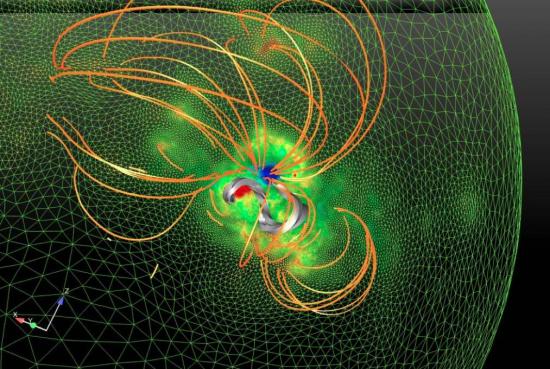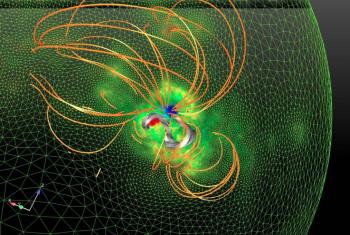Researchers at the Center for Theoretical Physics (CNRS / Ecole Polytechnique) and Astrophysics Department-Laboratory AIM (CNRS / CEA / Université Paris Diderot) have identified a key phenomenon in the emergence of solar flares. Using satellite data and numerical modeling, the researchers were able to follow the evolution of the solar magnetic field in a specific area of the Sun that gave rise to a flare. Their calculations showed the formation of a "magnetic rope" [1] emerging from the internal atmosphere of the Sun and associated with the appearance of a sunspot. They show that this structure plays an important role in the onset of the flare. By modeling the complete evolution of the flare, this work opens the way to predicting solar storms that affect Earth. These results are on the front cover of Nature of 23 October 2014.
Anticipating solar explosions
Solar flares are events that take place in the Sun's atmosphere. They are characterized by emission of light and particles as well as for those on a large scale, also called coronal mass ejections, by issuing a bubble of hot gas.
Understanding the origin of these phenomena is interesting on several levels:
• These are examples around us of physical phenomena occurring throughout the Universe and particularly illustrating the interaction of hot material with the magnetic field.
• But it is mainly because of their impact on the Earth's environment that the study and prediction of flares is an important issue. They actually generate multiple disturbances on Earth affecting among other electrical generators on the ground, as well as GPS satellites and communication systems. Anticipating major solar flares has become a priority for the protection of many technological systems.

Left: example of a solar flare observed on the edge of the Sun on October 14 2012. arising from a sunspot, a bubble of hot gas is trapped by arch structure of the sun's magnetic field whose dimensions can reach more 100 000 km in size (by comparison, an image of the Earth on the scale was superimposed in the center of the arch). When the arch is ruptured by the gas pressure, the material is ejected into space and can reach the Earth causing strong disturbances in the atmosphere (Credit NASA / SDO). Right: The modeling of the magnetic rope observed during the eruption of December 13, 2006, projected on the solar limb, showing the similarity of the two events (© Tahar Amari / Centre de physique théorique)
Eruptions from the energy of the magnetic field
The solar atmosphere is divided into several layers, the photosphere - the equivalent of the Sun's surface - and the corona, the outermost zone where flares take place. There is a magnetic field in these layers that plays a leading role in solar flares as it provides most of the energy with the most intense eruptions reaching up to 10% of the total energy radiated by Sun.
So far the observations did not allow to understand the exact mechanism and structures involved, partly because it is difficult to estimate the magnetic field at any point in the solar corona because the hot coronal gas is of too low density.
However, an eruption occurred on the night of December 12 to 13, 2006, that produced a breakthrough: the area of the Sun concerned by the flare was observed by the Japanese satellite Hinode at the time of the flare and in the preceding days. Data on the magnetic field of the photosphere, colder and denser than the corona, have been collected by the satellite and allowed the researchers to calculate the evolution of the magnetic environment in the corona during this episode.

Modelling of the magnetic field in the region of the Sun where a major flare occurred on December 13 2006 This model is obtained by using magnetic field data measured at the surface of the Sun and a adaptive high resolution numerical code. It highlights the presence of a magnetic rope (gray) a few hours before the eruption, maintained in equilibrium state by magnetic arcades (orange). © Tahar Amari / Centre for Theoretical Physics
Using calculations performed at Idris (Institut du développement et des ressources en informatique scientifique- CNRS), scientists have shown that a characteristic structure in the form of "magnetic rope" appears gradually in the days before the flare until his complete formation on the eve of the phenomenon. This result is consistent with observations at the photosphere and corona: the formation of the magnetic rope matches with the evolution of sunspots in the region of the flare and the appearance of other phenomena such as X-ray emission in "S" shape, extreme ultraviolet emission and a protuberance of cold material, all observed before the eruption. Their calculations also highlight that the magnetic energy of the string increases as it emerged from the interior of the Sun.
With a full numerical simulation of the phenomenon, the researchers then followed the evolution of the magnetic field in the corona once the cord has formed. Their results show that this structure is at the origin of the flare and is required for the phenomenon to occur. The transition to the final phase of the flare is not possible before its formation. Several criteria then come into play:
- An energy threshold to be achieved for the system which is close to a maximum energy
- A given altitude beyond which the magnetic arches that hold the rope weaken.
If these criteria are achieved, then a solar flare can take place.
This work shows that it is now possible to envisage a true prediction of solar flares. Based on data from the solar magnetic field accumulated in "real time" and a string of suitable numerical models, it may eventually be possible, much like standard meteorology, to predict the weather in space and prevent impact of solar storms on Earth.
Contact : Jean-Jacques Aly
Publication :
« Characterizing and predicting the magnetic environment leading to solar eruptions » Tahar Amari, Aurélien Canou and Jean-Jacques Aly published in Nature on 23 octobre 2014 (click  for a numerical version)
for a numerical version)
see also - the CNRS-CEA press release (23 octobre 2014)
Notes :
[1] A magnetic rope is a tangle of magnetic field lines twisted like a rope of hemp.
Redaction : T. Amari, DCOM CEA, J.M. Bonnet-Bidaud




